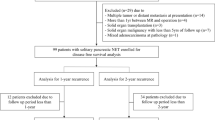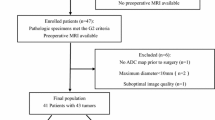Abstract
Purposes
Predictive factors of lymph node metastasis (LNM) in pancreatic neuroendocrine tumors (pNETs) are not well established. We sought to identify the value of MR imaging features in preoperatively predicting the lymph node metastasis of pNETs.
Materials and methods
In this study, we enrolled 108 consecutive patients with pNETs between January 2009 and June 2018. MR morphologic features and quantitative data were evaluated. Predictors of LNM were evaluated using univariate and multivariate logistic regression models.
Results
A total of 108 patients with pNETs were finally enrolled, including 82 LNM-negative and 26 LNM-positive patients. Features significantly related to the LNM of pNETs at univariate analysis were tumor size > 2 cm (P = 0.003), Ki-67 > 5% (P = 0.002), non-enhancement pattern (P < 0.001), apparent diffusion coefficient value (P < 0.001), main pancreatic duct dilation (P < 0.001) and pancreatic atrophy (P = 0.032) and extrapancreatic tumor spread (P = 0.001), CNRs during arterial, portal and delay phase (P = 0.005, 0.047, and 0.045, respectively), and histological classification (P = 0.006). At multivariate analysis, non-enhancement pattern (P = 0.019; odds ratio, 6.652; 95% CI 1.369, 32.321) and main pancreatic duct dilation (P = 0.018; odds ratio, 6.745; 95% CI 1.379, 32.991) were independent risk factors for predicting the LNM of pNETs.
Conclusion
The non-enhancement characteristic and main pancreatic duct dilation appear to be linked with LNM in pNETs. These radiological predictors can be easily obtained preoperatively, and may help to avoid missing pNETs with a high risk of LNM.





Similar content being viewed by others
References
Kartalis N, Mucelli RM, Sundin A. (2015) Recent developments in imaging of pancreatic neuroendocrine tumors. Ann Gastroenterol 28: 193-202
Oberg K, Sundin A. (2016) Imaging of Neuroendocrine Tumors. Front Horm Res 45: 142-51
Rindi G, Kloppel G, Alhman H, et al. (2006) TNM staging of foregut (neuro)endocrine tumors: a consensus proposal including a grading system. Virchows Arch 449: 395-401
Jiang Y, Jin JB, Zhan Q, Deng XX, Shen BY. (2015) Impact and Clinical Predictors of Lymph Node Metastases in Nonfunctional Pancreatic Neuroendocrine Tumors. Chin Med J (Engl) 128: 3335-44
Hashim YM, Trinkaus KM, Linehan DC, et al. (2014) Regional lymphadenectomy is indicated in the surgical treatment of pancreatic neuroendocrine tumors (PNETs). Ann Surg 259: 197-203
De Robertis R, Maris B, Cardobi N, et al. (2018) Can histogram analysis of MR images predict aggressiveness in pancreatic neuroendocrine tumors? Eur Radiol 28: 2582-2591
Lotfalizadeh E, Ronot M, Wagner M, et al. (2017) Prediction of pancreatic neuroendocrine tumour grade with MR imaging features: added value of diffusion-weighted imaging. Eur Radiol 27: 1748-1759
Wang Y, Chen ZE, Yaghmai V, et al. (2011) Diffusion-weighted MR imaging in pancreatic endocrine tumors correlated with histopathologic characteristics. J Magn Reson Imaging 33: 1071-9
Jeon SK, Lee JM, Joo I, et al. (2017) Nonhypervascular Pancreatic Neuroendocrine Tumors: Differential Diagnosis from Pancreatic Ductal Adenocarcinomas at MR Imaging-Retrospective Cross-sectional Study. Radiology 284: 77-87
Nanno Y, Toyama H, Otani K, et al. (2016) Microscopic venous invasion in patients with pancreatic neuroendocrine tumor as a potential predictor of postoperative recurrence. Pancreatology 16: 882-7
Curran T, Pockaj BA, Gray RJ, et al. (2015) Importance of lymph node involvement in pancreatic neuroendocrine tumors: impact on survival and implications for surgical resection. J Gastrointest Surg 19: 152-60
Taki K, Hashimoto D, Nakagawa S, et al. (2017) Significance of lymph node metastasis in pancreatic neuroendocrine tumor. Surg Today 47: 1104-1110
Mizumoto T, Toyama H, Terai S, et al. (2017) Prediction of lymph node metastasis in pancreatic neuroendocrine tumors by contrast enhancement characteristics. Pancreatology 17: 956-961
Boninsegna L, Panzuto F, Partelli S, et al. (2012) Malignant pancreatic neuroendocrine tumour: Lymph node ratio and Ki67 are predictors of recurrence after curative resections. European Journal of Cancer 48: 1608-1615
Bettini R, Partelli S, Boninsegna L, et al. (2011) Tumor size correlates with malignancy in nonfunctioning pancreatic endocrine tumor. Surgery 150: 75-82
Jiang Y, Jin JB, Zhan Q, et al. (2015) Impact and Clinical Predictors of Lymph Node Metastases in Nonfunctional Pancreatic Neuroendocrine Tumors. Chin Med J (Engl) 128: 3335-44
Parekh JR, Wang SC, Bergsland EK, et al. (2012) Lymph node sampling rates and predictors of nodal metastasis in pancreatic neuroendocrine tumor resections: the UCSF experience with 149 patients. Pancreas 41: 840-4
Gratian L, Pura J, Dinan M, et al. (2014) Impact of extent of surgery on survival in patients with small nonfunctional pancreatic neuroendocrine tumors in the United States. Ann Surg Oncol 21: 3515-21
Postlewait LM, Ethun CG, Baptiste GG, et al. (2016) Pancreatic neuroendocrine tumors: Preoperative factors that predict lymph node metastases to guide operative strategy. J Surg Oncol 114: 440-5
Rodallec M, Vilgrain V, Couvelard A, et al (2006) Endocrine pancreatic tumours and helical CT: contrast enhancement is correlated with microvascular density, histoprognostic factors and survival. Pancreatology 6: 77-85
Worhunsky DJ, Krampitz GW, Poullos PD, et al. (2014) Pancreatic neuroendocrine tumours: hypoenhancement on arterial phase computed tomography predicts biological aggressiveness. HPB (Oxford) 16: 304-11
Hyodo R, Suzuki K, Ogawa H, et al. (2015) Pancreatic neuroendocrine tumors containing areas of iso- or hypoattenuation in dynamic contrast-enhanced computed tomography: Spectrum of imaging findings and pathological grading. Eur J Radiol 84: 2103-9
Kim JH, Eun HW, Kim YJ, et al. (2016) Pancreatic neuroendocrine tumour (PNET): Staging accuracy of MDCT and its diagnostic performance for the differentiation of PNET with uncommon CT findings from pancreatic adenocarcinoma. Eur Radiol 26: 1338-47
Nanno Y, Matsumoto I, Zen Y, et al. (2017) Pancreatic Duct Involvement in Well-Differentiated Neuroendocrine Tumors is an Independent Poor Prognostic Factor. Ann Surg Oncol 24: 1127-1133
Funding
The authors received no financial support for the research, authorship, and/or publication of this article.
Author information
Authors and Affiliations
Corresponding author
Ethics declarations
Conflict of interest
The authors declare that they have no conflict of interest.
Ethical approval
All procedures performed in studies involving human participants were in accordance with the ethical standards of the institutional and/or national research committee and with the 1964 Helsinki Declaration and its later amendments or comparable ethical standards.
Informed consent
This retrospective study was approved by the institutional review board and informed consent was waived.
Rights and permissions
About this article
Cite this article
Sun, H., Zhou, J., Liu, K. et al. Pancreatic neuroendocrine tumors: MR imaging features preoperatively predict lymph node metastasis. Abdom Radiol 44, 1000–1009 (2019). https://doi.org/10.1007/s00261-018-1863-y
Published:
Issue Date:
DOI: https://doi.org/10.1007/s00261-018-1863-y




